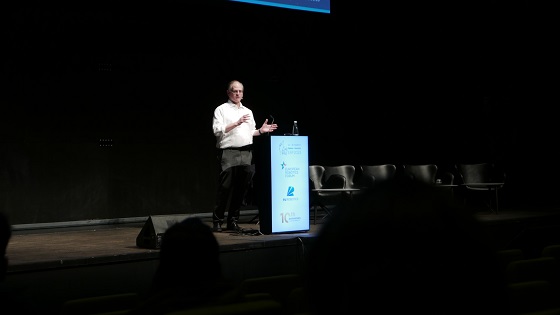Yesterday Teradyne CEO Greg Smith addressed the audience at ERF 2023 in a keynote, highlighting the role robotics companies Universal Robots and MiR, both acquired by Teradyne in recent years, play in the strategy of the US-based technology company. With currently 11 million cobots that could be sold, the potential market for cobots is around $500 billion.
Smith started off with describing the company’s journey in the electronics and semiconductor industry. Founded in 1960, Teradyne has been a key player in selling equipment for testing electronics and semiconductors. In 2015, the company expanded its offerings to include next-generation collaborative robotics. Currently, Teradyne has a team of approximately 6,500 employees spread across different countries such as Denmark, the United States, the Philippines, Costa Rica, and other nations worldwide. As of 2022, the company had generated revenue of about $3.1 billion.
Mr. Smith emphasized that the test equipment market is a differential market. He explained that a differential market means that if the same number of chips are produced next year as were produced this year, the world would not require any more test equipment. Therefore, the only way the company can have a market is if the end market for semiconductors grows, either in complexity or in units. This leads to a challenging boom-bust cycle for the semiconductor industry.
Long-term growth
Therefore, one of the critical factors they looked for was a long-term growth opportunity that is driven by a complementary global trend. Teradyne also wanted to identify a market ripe for disruption or innovation that would enable them to sneak in and grow. Finally, they aimed to find a business where their experience over the last 50 years would help foster market growth.
After an extensive search, Teradyne found collaborative robotics to be the best fit, and Universal Robots was acquired. The company had a vast market, an innovative product, and was ripe for disruption. Teradyne believed that its experience as a global industrial toolmaker could help scale the business. In 2018, they also acquired a great company with a breakthrough technology in autonomous mobile robots.
Capabilities
Smith highlighted that they wanted to enter a massive market, and the collaborative robotics sector is an area of high growth potential, according to a model based on the capabilities of cobots and AMRs and the number of people employed in industries where they could be deployed. About 14% of the 160 million worldwide manufacturing jobs were automatable using cobots, while about 10% of the 100 million people employed in material handling and transportation could be covered by automated conveyors or fork trucks.
These figures, which Teradyne divided by two to account for two-shift operations, yielded an estimate of 11 million cobots that could potentially be sold. Currently, the total installed base of cobots is less than 2% of that figure, making the potential market for cobots around $500 billion. As for AMRs, Smith said that there were around 5 million of these robots that could be deployed in a range of industries. However, the total installed base was less than 200,000, indicating that the market for AMRs was also in its infancy.
Speed
He concluded: “Our behavior is driven by this potential market. We believe that the speed at which the industry can create solutions is what drives our success. People sometimes portray robots as job killers. I think that the lack of human-scale automation is actually an economy killer. It is holding back industrialized economies from achieving their full potential.”
“We are seeking to profoundly transform global manufacturing with robots that work alongside people. To accomplish this enormous mission, we are applying principles that come from 60 years of living at the cutting edge of technology and serving some of the most demanding manufacturing customers in the world.”
Transformation
“Over my career, I feel incredibly lucky to have played a small part in the semiconductor industry, an industry that has changed the world. It has lifted billions of people out of poverty, helped to topple corrupt regimes, reshaped entire societies, and enabled a generation of digital natives to accomplish tasks in minutes that would have taken someone like me weeks.”
“I feel like robotics is putting us on the verge of a transformation that could be just as profound. This transformation will reduce drudgery, boost economic development, reduce waste, and make manufacturing more sustainable. It is my sincere hope that we can all build that future together. The transformation will take time, but by applying lessons from the past to the challenges of the future, we can accelerate change and make the world a better place with human-scale automation.”

